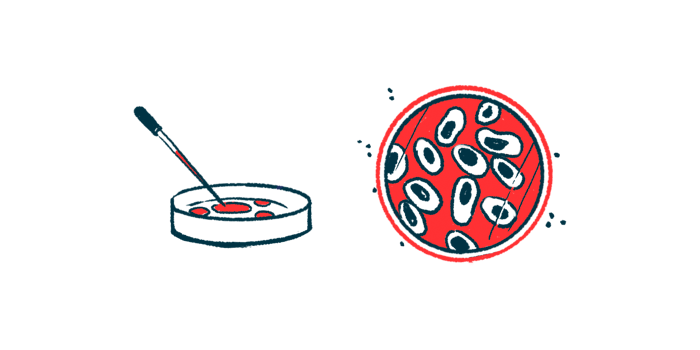SPAG17 Protein May Protect Against Scarring in SSc, Study Says
Lower SPAG17 protein levels were found in skin cells of people with scleroderma
Written by |

People with systemic sclerosis (SSc) have lower-than-normal levels of the SPAG17 protein in their skin cells, which contributes to the excessive scarring that marks the disease, a study suggests.
Mice lacking the protein developed signs of scarring, or fibrosis, consistent with that seen in people with SSc, also called scleroderma, and SPAG17 loss was found to promote pro-fibrotic processes in both human and mouse skin cells.
These findings highlight SPAG17 as a protective factor against fibrosis in SSc, while uncovering a new biological role for this poorly understood protein.
“This discovery advances our understanding of fibrosis and scar formation that underlie the lethal complications of scleroderma,” John Varga, MD, one of the study’s co-senior authors and chief of the rheumatology division at the University of Michigan, which houses an established scleroderma program, said in a university press release.
“We can now investigate why SPAG17 is suppressed in scleroderma and if there is a way to restore its function, resulting in reversal of fibrosis,” Varga added.
The study, “Reduced SPAG17 expression in systemic sclerosis triggers myofibroblast transition and drives fibrosis,” was published in the Journal of Investigative Dermatology.
Myofibroblasts are temporarily activated to promote wound repair
Fibroblasts are a type of connective tissue cell that mature into myofibroblasts during wound healing. Myofibroblasts are temporarily activated to promote wound repair by producing extracellular matrix (ECM) molecules such as collagen.
But in SSc, myofibroblasts accumulate and persist at tissue lesion sites, driving the buildup of ECM molecules and scar tissue on the skin and inside the body’s organs. However, the mechanisms that underlie myofibroblast persistence aren’t well-established.
In a previous study to identify the molecular underpinnings of that process, Varga and colleagues analyzed gene activity differences between skin samples from 19 SSc patients and 15 healthy people, who served as controls.
Among the 526 genes whose activity was found to be reduced and the 1,200 genes whose activity was increased in the skin of SSc patients, the SPAG17 gene “displayed the most significant variation,” the researchers wrote.
The gene, which provides the instructions to produce a protein of the same name, has predominately been linked to the function of cilia, the hair-like structures on cell surfaces that help with cellular motility and sensory functions. However, its full role in the body remains largely unclear.
Now, some of the researchers set out to further explore the potential role of SPAG17 in SSc.
This discovery advances our understanding of fibrosis and scar formation that underlie the lethal complications of scleroderma
They first found that compared with the healthy group, SPAG17’s activity was significantly reduced in skin samples from patients with limited and diffuse cutaneous forms of SSc — but especially in the diffuse group, which had more severe disease.
Lower SPAG17 activity levels were also associated with more severe skin involvement among patients.
In an independent group of 48 early-stage SSc patients and 33 healthy people, the researchers confirmed that the activity of the SPAG17 gene was significantly reduced in the skin of patients with diffuse cutaneous SSc.
SPAG17 activity levels were most prominently reduced in fibroblasts and, in particular, myofibroblasts. The gene was no longer active in as many as 30% of patient fibroblasts, and its activity was “virtually undetectable” in activated myofibroblasts from SSc skin samples.
This reduced gene activity indeed translated into lower levels of the resulting SPAG17 protein in fibroblasts and blood vessel cells from patient skin samples.
When researchers genetically removed the SPAG17 gene from mice, the animals experienced skin changes consistent with the fibrosis observed in the skin of SSc patients. These changes, which were most notable at 3–5 months of age, included skin thickening and stiffening, as well as alterations to the organization of collagen.
The team noted, however, that additional studies are needed in these mice to further understand the role of SPAG17 in disease progression and development of multi-organ fibrosis.
Lab-grown fibroblasts lacking SPAG17 gene show signs of pro-fibrotic processes
Further analyses showed that both patient skin samples and fibroblasts from SPAG17-deficient mice had increased activity of genes previously linked to pro-fibrotic processes, with significant overlap between human and mouse results.
Lab-grown human and mouse skin fibroblasts lacking the SPAG17 gene both showed signs of pro-fibrotic processes, such as higher levels of alpha-SMA — a marker of myofibroblasts — and increased collagen production.
TGF-beta signaling, a known pro-fibrotic signaling cascade, was also increased in SPAG17-deficient mouse fibroblasts, and treatment with TGF-beta suppressors resulted in a reduction in pro-fibrotic features.
“These observations support a previously unrecognized … function for SPAG17 as a regulator of myofibroblast [maturation] and fibrotic responses,” the researchers wrote.
“SPAG17 appears to play a crucial role in regulating connective tissue [balance], and its profound dysregulation in SSc patients may directly contribute to the development or progression of skin fibrosis,” they added.
However, the mechanisms behind this role are still unclear, the team noted.
“Further studies on the regulation, [activity] and role of SPAG17 in fibrosis and the underlying mechanisms may inform the search for innovative therapies for SSc and other fibrotic conditions,” the researchers concluded.







